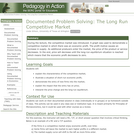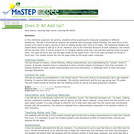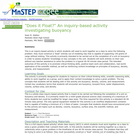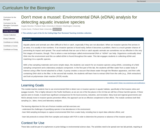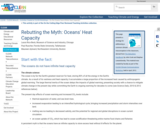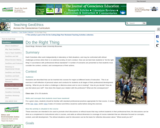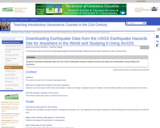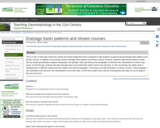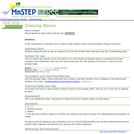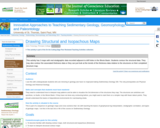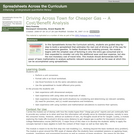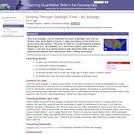This exercise is typically integrated with lecture during the first two days of a chapter on fluvial geomorphology.
Day 1:
The first day of class begins with a discussion of the components of a drainage basin and typical drainage basin patterns, including dendritic, parallel, trellis, rectangular, radial, annular, and multibasinal. After viewing the typical textbook diagrams of these drainage basin patterns, each student is given his/her own topographic map and a geologic map from the same region. The students are given the following instructions:
1.Write a one paragraph description of your study area, and include the following information:
Quad. name
Drainage basin pattern(s) -- in bold
Geological influence
2.Email the paragraph to me as an MS Word document by 9:00AM on [date -- next day]. I will read the paragraph, but I will not modify any wording, so make sure it is accurate and well-written.
The maps are usually distributed in the last 10 minutes of a 50-minute class period, so that the students have some time to get familiar with the maps and ask any questions that arise immediately. Recommended 7.5 minute quad.s for the exercise include:
dendritic: Effingham, IL; Alma, WI-MN
parallel: Ithaca West, NY; Antelope Peak, AZ
trellis: Waldron, AR
rectangular: Hillsboro, KY; Cumberland MD-PA-WV
radial: Mt. Rainer, WA
annular: Maverick Spring, WY
multibasinal: Whitwell, TN; Oolitic, IN
The Website http://rockyweb.cr.usgs.gov/outreach/featureindex.html is also a useful reference for other topographic maps.
Day 2:
On the second day of class, we discuss the initiation of channels and basin morphometry. After lecturing on topics like tractive force, micropiracy, cross-grading, and bifurcation, we discuss typical stream courses (i.e., insequent, consequent, subsequent, obsequent, and resequent). In the last 5 minutes of class, the paragraphs from the previous day are redistributed in such a way that every student has a paragraph written by one of their peers and a new set of maps. The students are given the following instructions:
1.Rewrite/edit what you have been given, if necessary, to emphasize the bolded drainage pattern.
2.Decide whether the stream patterns are representative of consequent, insequent, or subsequent stream courses.
3.Explain your reasoning using the geologic map.
Discuss the influence of the resistance of geologic materials on the stream course.
Discuss the influence of slope on the development of the stream course.
4.Email the paragraph to me as an MS Word document by 9:00AM on [date -- next day].
Once final paragraphs are submitted, they are redistributed to the entire class so that all students have a complete set of paragraphs describing a variety of drainage basin patterns and stream courses from a variety of geologic settings. Maps remain in the classroom for the duration of the term so that students can reference them if they choose to.
Designed for a geomorphology course
Has minimal/no quantitative component
(Note: this resource was added to OER Commons as part of a batch upload of over 2,200 records. If you notice an issue with the quality of the metadata, please let us know by using the 'report' button and we will flag it for consideration.)
